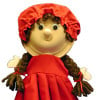DIY Winter Olympics - Make your own torch
The Olympic Games are the biggest world-wide sporting competition, held every two years. There are winter games and summer games that alternate every other year. This year (2014) in February the winter games will be occurring in Sochi, Russia.
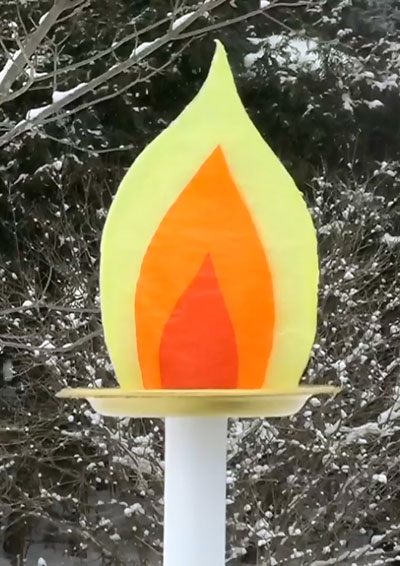
History
The first Olympics were said to be created by Hercules and they were games to honor his Father (chief of the Gods), Zeus. These games started in the eighth century BC and occurred frequently in Athens, Greece until the fourth century AD. Chariot races, running races, boxing, wrestling and the discus throw were some of the events present in the early Olympic Games. Instead of medals, the winners of the different events received an olive branch. Much more, the winners were highly regarded within the ancient community, they received cash prizes and were treated similar to celebrities today.
The Olympics as we know them today began in 1896 and they were held in Athens, Greece. The first winter games were in 1924 in France. The games were created to strengthen relations among countries. Nations come together and participate in friendly, sports competitions; it provides a positive line of communication amongst participating countries. The Olympic flag itself is a symbol of unity. On the flag are five rings that are interlocked together. These rings represent the five inhabited continents being: Africa, America, Asia, Australia and Europe. The colors of the rings are blue, yellow, black, green and red. These colors represent the colors that are present on National flags throughout the world (every flag worldwide has at least one of those colors). Not all nations of the world participate in the Olympics but more than two hundred nations currently take part in the games.
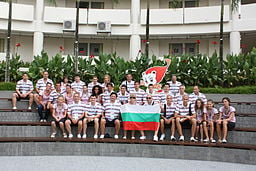
The Youth Olympic Games
Although the Olympic Games are for adult athletes (age 18 and older), recently the Youth Olympic Games were established. They began in 2010 and were first held in Singapore. Anyone aged 14-18 can participate. Practice your sport, participate in the qualifying games held within individual countries, and you may win the chance to participate in the Youth games which also will occur this year (2014) in the summer, in Nanjing, China. Similar to the regular Olympics, the youth Olympics occur every two years, alternating between the winter and summer games.
The most important thing in the Olympic Games is not winning but taking part; the essential thing in life is not conquering but fighting well.
Pierre de Coubertin
The Olympic Spirit
The athletes who compete in these games are held in high regard and are professionals in their sports. They have trained long and hard in order to compete. The participants are disciplined and competitive; they are determined to win. Many of these athletes fall short in the Olympic Games; they may not win a medal. These athletes are devoted to their sport, they don’t give up if they fail; they push themselves harder and try again. They may never win but that is not the most important thing. What is most important is that they tried their best and worked hard. Like anything in life we should try our hardest and push ourselves to achieve. In life we may not win a gold medal for everything we do but that doesn’t mean we should give up. We need to keep going, keep pushing ourselves to become better and stronger each day. Someday we will recognize that the real prize is in participating.

The Olympic Torch
When the original games were held in ancient Greece, a continuous flame was maintained in Olympia.
At the 1936 Games in Berlin, the tradition was started to transport the flame from Olympia to the place where the Games were held. A torch is lit from the fire in Olympia and then carried by runners who relay each other until the destination is reached. Sometimes the flame is transported by boat or by plane, and this year the Olympic torch even made a trip to the International Space Station.
Make your own torch
You'll mainly need:
- small paper plate
- tube of toilet paper roll
- long thin cardboard tube
- waxed paper
- yellow, orange and red tissue paper
- white glue
- Mod Podge
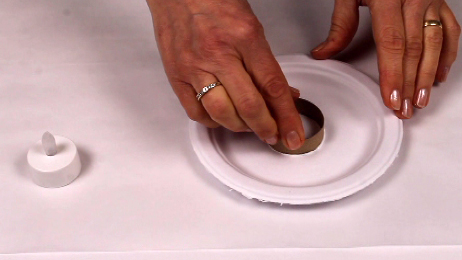
Cut a 1 inch slice of toilet paper roll and glue it in the center of the small paper plate.
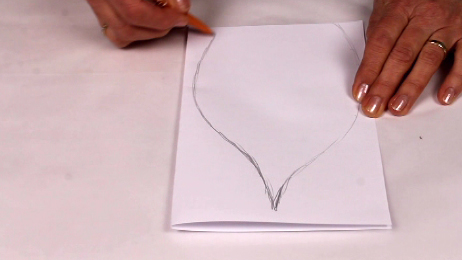
Take a sheet of paper and fold it in half to get the appropriate size to draw the pattern of the flame. Draw the outline of a large flame and cut it out.
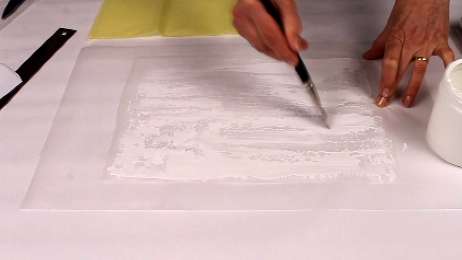
Cut a piece of wax paper that is at least twice the size of the pattern of the flame and spread diluted white glue or Mod Podge on the waxed paper.
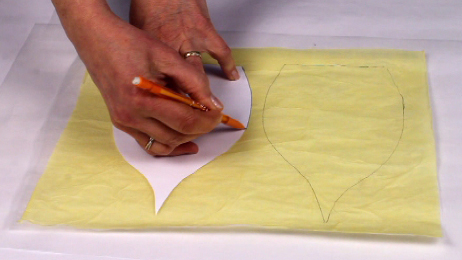
Cover the surface with a sheet of yellow tissue paper. Let dry.
When the yellow tissue paper is dry, trace the outline of the pattern of the big flame on one half of the tissue paper and then reverse the pattern and trace the outline on the other half of yellow tissue paper.
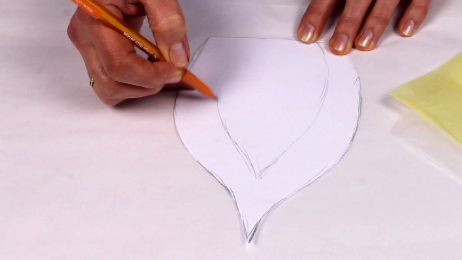
Draw a smaller flame inside the pattern and cut it out. This forms the medium size flame pattern.
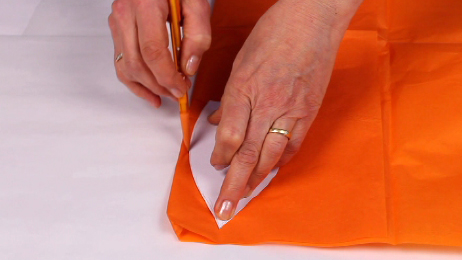
Take a piece of orange tissue paper that you fold in half. Then, trace the outline of the medium size flame pattern on the orange tissue paper.
Cut both layers of the orange tissue paper.
Spread diluted white glue or Mod Podge on the yellow tissue paper and place an orange flame on one of the yellow flames. Then, reverse the other orange flame and glue it on the other yellow flame. Let dry.
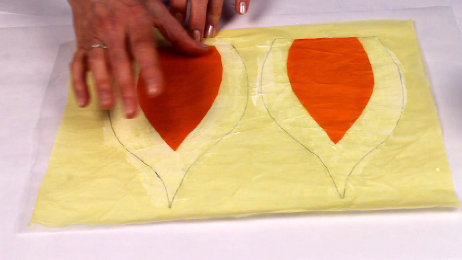
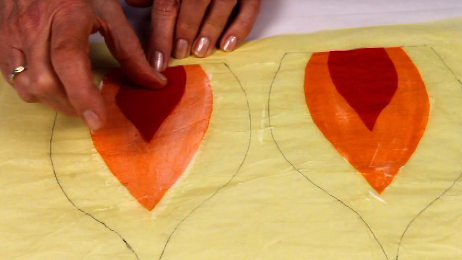
Draw a smaller flame inside the medium size pattern to form a small flame pattern.
Cut two small flames from red tissue paper and glue them on the orange flames.
When it's dry, brush the red tissue paper with diluted white glue or Mod Podge to make it shiny as well and let dry.
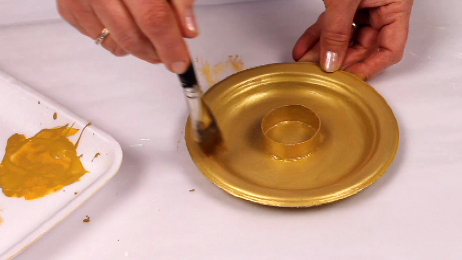
Take the plate with the ring of toilet paper roll that you glued earlier and paint both sides of the plate in a color of your choice.
I painted this part of the torch in gold. Because the gold paint is very transparent, begin by painting with a solid color very close to the gold color, e.g. ocher. Then, when the ocher paint is dry, add a layer of gold paint.
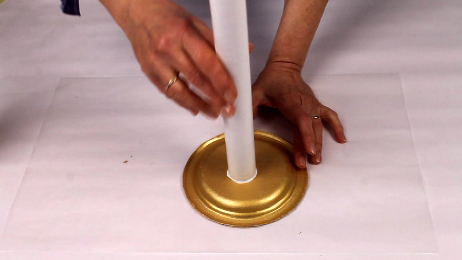
Then, paint the handle of the torch in a color of your choice. Let dry.
When the plate and the handle are dry, flip the plate over and glue the long tube in the center of the back of the plate. Let dry completely.
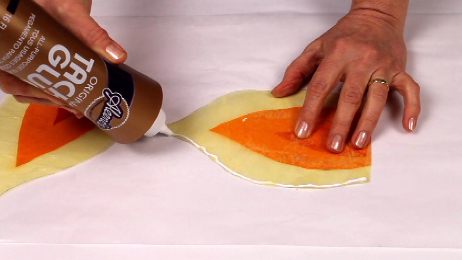
Take the wax paper covered with tissue paper and cut both sides of the flame.
Take one of the sides of the flame and place it with the waxed paper side up.
Put a thin bead of white glue all along the edge of the flame, with the exception of the bottom.
Superpose both sides of the flame exactly. To obtain good adhesion of both sides, put clothespins along the edge of the flame for a few minutes. Then, remove the clothespins and let dry completely.
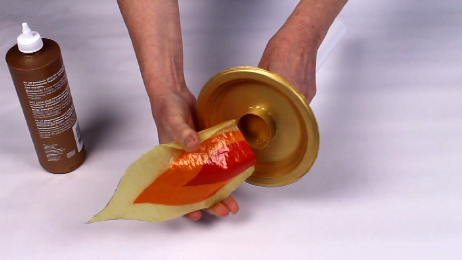
To mount the flame on the torch, open the bottom of the flame and insert the ring of toilet paper roll into the hole of the flame.
If you are going to use the Olympic torch during the day, glue the flame on the plate with white glue and let dry.
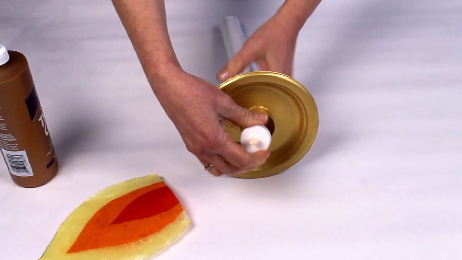
To use the torch in the evening, put a LED candle in the ring created with the roll of toilet paper.
Then glue the flame with a glue gun or with a few discrete pieces of scotch tape.
Video tutorial
If you'd rather watch a video with the explanations, you'll find one here.
